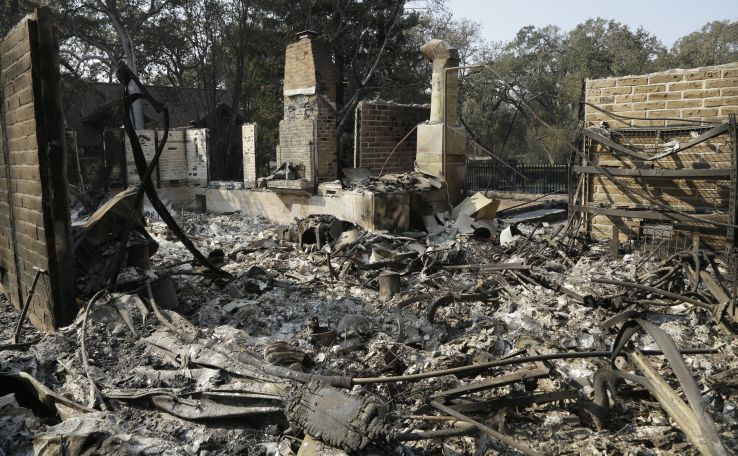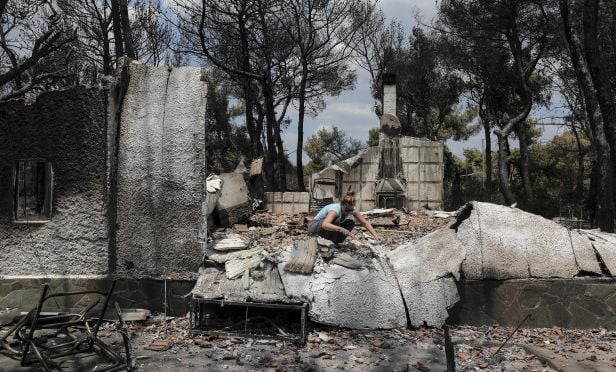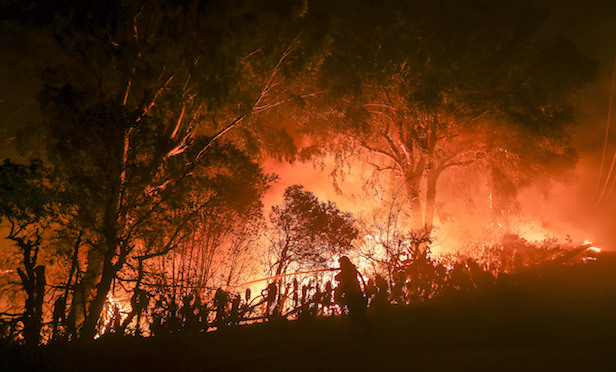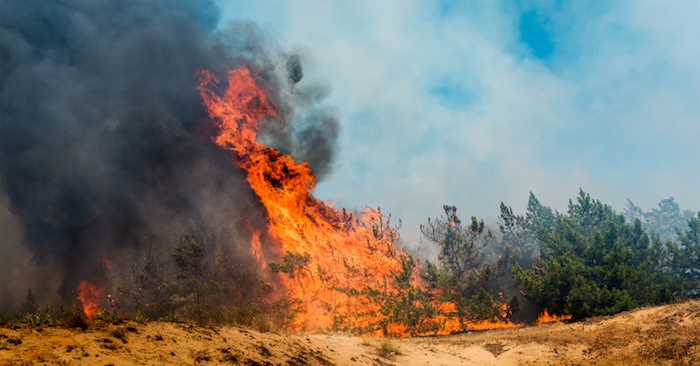 Remains of a home destroyed by wildfires seen Wednesday,Oct. 18, 2017, in Glen Ellen, Calif. California fire officials havereported significant progress on containing wildfires that haveravaged parts of Northern California. The fires that swept throughparts of seven counties starting Oct. 8 were the deadliest and mostdestructive series of blazes in California history. (AP Photo/BenMargot)
Remains of a home destroyed by wildfires seen Wednesday,Oct. 18, 2017, in Glen Ellen, Calif. California fire officials havereported significant progress on containing wildfires that haveravaged parts of Northern California. The fires that swept throughparts of seven counties starting Oct. 8 were the deadliest and mostdestructive series of blazes in California history. (AP Photo/BenMargot)
California and other Western states suffered historically severewildfires following years of significant drought.
|Estimates of damage for California alone were $9.4 billion as ofearly December 2017, and that figure is destined to rise as alldamages are finally assessed and claims are completed.
|Some estimate that the final number will be about $180 billion,but only time will tell. Aside from the fire damage itself and lossof life, there are many secondary issues that arise.
|Related: California proposes stronger laws to help wildfiresurvivors with insurance claims
|Fire is virtually always a covered peril, and it's used as thestandard covered peril example. So it comes with some surprise thatwith the significant wildfires this season the CaliforniaDepartment of Insurance is concerned that the extent of damagecould discourage carriers from writing new policies in theseareas.
|Residential property losses in Sonoma County alone exceed $2.6billion. Napa County sustained commercial losses of more than $3.2million and residential losses of more than $266 million.Residential losses from all fires are more than $3.1billion, with commercial losses at $137 million.
|Already insurers have refused to renew more than 10,000 policiesin the counties most vulnerable to wildfires. This is an increaseof 15% from last year. There are 1.3 million homes determined to beat high or very high risk of fire.
|Random house fires caused by Christmas trees, cooking accidents,open flames and other situations result in a large number of fires,but they're in varied areas at varied times. With wildfires, alarge portion of a carrier's insured properties are exposed tocatastrophic losses all at once. This is driving the concerns ofcarriers, as well as the fact that more development has occurred inareas closer to wildfire zones. Unless the homes are underinsuredthough, the policyholders are covered for their losses. Theaftermath, however, is a different story.
|Burn scars more than landscape
When wildfires destroy an area, the result is known as a burnscar. This is an area of ground that's now charred, barren anddevoid of vegetation. The trees, plants and vegetation perform avital purpose and hold the soil in place to absorb rainfall. Whenthe trees, plants and vegetation are gone, the chance of mudslidesand rockslides from rain is greatly increased.
|Related: 10 things your clients need to know aboutwildfires
|California's wet season begins in October, runs through March,and produces most of California's annual rainfall. The scorchedareas can be as water-repellant as pavement, so water can run offextremely quickly causing flash floods and debris flows.
|As rainstorms hit California recently, several flash floods,mudflows and landslides occurred, causing moreproperty damage as well as taking lives. Without the vegetation,the rain easily saturated the earth, which rapidly becamefast-moving sheets of mud and debris headed downhill. People wereagain evacuated, but this time for a different reason. Houses thatavoided the fires were carried off their foundations by mudflows.One freeway was closed for 30 miles and parts of the road werecompletely submerged.
||Exclusions for earth movement
Landslides, mudslides and mudflows are all considered earth movement under the standard homeownerspolicy, and are excluded. The exclusion falls under"anticoncurrent causation" language, so even though the wildfiresmay have contributed in some way to the loss, the damages areexcluded.
|But what if an insured had already been evacuated due to thewildfires or was receiving additional living expenses due to damagefrom the fire, and the mudslides caused more damage, increasing thetime the insured's residence is uninhabitable?
|Related: Wildfire claims and coveragequestions
|Unfortunately, for the insured, the additional living expensesare available only if the loss is covered under Section I of thepolicy. Even under civil authority, the damage to a neighboringpremises must be by a peril insured against.
|Therefore, in order for insureds to have coverage for themudslides, landslides and mudflows, the insureds may look to aflood policy if they have one. The National Flood Insurance Program (NFIP) policyincludes mudflow and the unusual and rapid accumulation or runoffof surface waters from any source in the definition of flood.
|In order for the coverage to apply there must be an inundationof two or more acres of normally dry land or two or moreproperties, one of which is the insured's. The policy makes adistinction between mudflow and landslides, and it states thatlandslides, slope failure or a saturated soil mass moving byliquidity down a slope are not mudflows. Mudflows are rivers ofliquid and flowing mud on the surface of normally dry areas.
|Coverage for mudflows
Therefore, in relation to the current situation in California,the flood policy only covers mudflows. Although damage from themudflow is covered, the NFIP policy provides no coveragefor additional living expenses while the building is uninhabitableand under repair.
|Looking for coverage elsewhere, there is an earthquakeendorsement available through ISO HO 04 54 Earthquake and inCalifornia HO 22 33 Earthquake — California. Unfortunately, thecoverage provided in these endorsements is for earthquake,including land shock waves or tremors. There is no coverage forlandslide outside of an earthquake, and the form excludes flood aswell, even if it was caused by, resulted from, contributed to orwas aggravated by an earthquake.
|Tricky coverage questions
The current situation in California after the wildfires andmudslides is extremely difficult for insureds. The homeowners formand a flood policy cover parts of these losses; the homeownerspolicy covers the fire damage, and if the insured has a floodpolicy, that will cover the mudflows. Damages from landslidesoutside of the mudflows, if a carrier determines that a landslideand not a flood or mudflow is the cause of damage, are not coveredunder either policy.
|Related: Why flood insurance isn't like a homeowners'policy
|An insured may have additional living expenses after the fire,but the insured won't have such coverage after a mudflow. Howeverdifferentiating the losses between the two is tricky.
- If reconstruction or repair after the fire is not affected bythe mudflow, then the insured will have additional living expensesfrom the homeowners form through reconstruction.
- If the fire burned down part of the building leaving a holethat the mud flowed into, will the costs of removing the mud beincluded in the repair of the fire damage?
The mud must be removed before the repair can begin, butmudslide is not a covered peril. Technically the carrier could makea case that the removal of the mud is not covered as it is notdirect damage from the fire and that the insured must pay thoseexpenses separately.
|How carriers will handle it remains to be seen.
|Related: Snow, landslides & avalanches
|Christine G. Barlow, CPCU, is managing editor with FC&S,the premier resource for insurance coverage analysis. She has anextensive background in insurance underwriting. She may be reachedat [email protected]. Additionalinformation about FC&S Online is available at www.NationalUnderwriter.com.
Want to continue reading?
Become a Free PropertyCasualty360 Digital Reader
Your access to unlimited PropertyCasualty360 content isn’t changing.
Once you are an ALM digital member, you’ll receive:
- All PropertyCasualty360.com news coverage, best practices, and in-depth analysis.
- Educational webcasts, resources from industry leaders, and informative newsletters.
- Other award-winning websites including BenefitsPRO.com and ThinkAdvisor.com.
Already have an account? Sign In






